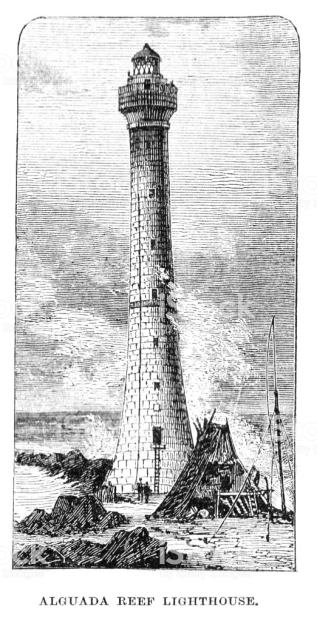
Another more tangible example of the many imperial connections between Scotland and Burma is the lighthouse at Alguada Reef, just off Cape Negrais in the Andaman Sea.
One of many British lighthouses in Burma, it was completed in 1865. The lighthouse stands 44 metres (144 ft.) tall and took 6 years to build because of its remote location.
The structure was originally designed by Scottish engineer Lieut-Col. Alexander Fraser (who also laid the original plan for the city of Rangoon), after a boat carrying 300 “coolie” laborers from Calcutta to Rangoon ship-wrecked on the reef in 1855. Only 11 men survived.

Then-Governor General of India, the Marquess Dalhousie, tasked Fraser with designing and building a light that would avoid further wrecks and be visible from 20 miles out at sea. Fraser made a tour of lighthouses on the Western coast of Scotland and England before submitting his plan.
He eventually settled on a design directly inspired by the Skerryvore Lighthouse in Scotland, which was built by engineer Alan Stevenson (uncle of Robert Louis Stevenson, of Treasure Island fame) in 1844, though Fraser altered it “to suit the requirements of an eastern climate.”


Building the light was especially difficult as construction was only possible during the Winter monsoon from Nov.-Apr. Moreover, storms frequently destroyed the work-site and, before a camp was built, it was impossible to stay on the island during high tide.
The granite for the tower came from 200 miles away in Callagouk (now Kalegauk Island) on the Tenasserim (Tanintharyi) Coast, and also from as far as Singapore. The workmen were convicts from the prison at Moulmein (Mawlamyaing), the contractors were from England, and the stonemasons were from Hong Kong.




When completed, the structure housed 2 European light-keepers, 5 local assistants, and a cook for seven months at a time – a lonely existence for such a long time out at sea.
Although its sister lighthouse Skerryvore is still operational, the site and tower at Alguada Reef are now closed. Nevertheless, they are still visible from satellite imagery available on the internet.




A great addition to the Stevenson narrative which indeed spread around the world. I recently visited the Stevenson lighthouse in Galle for which the granite was quarried in Scotland and transported by sea. The history of ballast indeed. I’ll be visiting Yangon (from Glasgow) in a couple of months time and see it through a new perspective.Thanks for enlightening us.
LikeLike